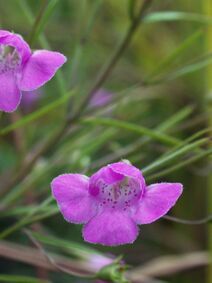Agalinis tenuifolia
| Agalinis tenuifolia | |
 | |
| Agalinis tenuifolia in bloom | |
| Light: | |
| Moisture: | |
| Hardiness: | 2 |
| Soil pH: | 5.6-8.4 |
| Height: | 2' |
| Blooms: | Mid Summer-Late Summer |
| Open Woods Forest | |
| Native to: | |
| Medicinal Rating: | |
| Tea: | Yes |
Agalinis tenuifolia (common name: slenderleaf false foxglove, slender false foxglove, and slender gerardia) is a forb with narrow leaves that trend toward purple in the fall. Its flower shape stands out from the other false foxgloves with two petals forming a hood and the other three flaring out. This annual prefers slightly disturbed habitats, but beyond that it's flexible about soil, moisture, and sun conditions. Members of the Agalinis genus serve as a food source for the larvae of the Common Buckeye butterfly. Like the other False Foxgloves, Slender False Foxglove is partially parasitic on the roots of other plants.
Propagation: Seed
Cultivation: Requires a well-drained soil, preferably on the dry side[1]. Grows well in a woodland garden[1].
This species is not very hardy outdoors in Britain, tolerating temperatures down to between -5 and -10°c[1].
A semi-parasitic plant, thus making it very difficult to establish in cultivation[2]. We are not sure which species it parasitizes[1].
Range: N. America.
Habitat: Moist open areas and low woods in Texas[3].
Medicinal: An infusion of the plant has been used in the treatment of diarrhea.[1]
Soil: Can grow in light and medium soils.
Drainage: Prefers well drained soil.
Flower Type: Hermaphrodite
Known Hazards: The plant is said to be poisonous to cattle and sheep.[3]
Also Known As: Gerardia tenuifolia.
Links
References
- ↑ 1.0 1.1 1.2 1.3 1.4 Moerman, Daniel. Native American Ethnobotany. Timber Press, 1998.
- ↑ Huxley, Anthony. The New Royal Horticultural Society Dictionary of Gardening. MacMillan Press, 1992.
- ↑ 3.0 3.1 Diggs, George and Barney Lipscomb. Illustrated Flora of North Central Texas. Botanical Research Institute, 1999.